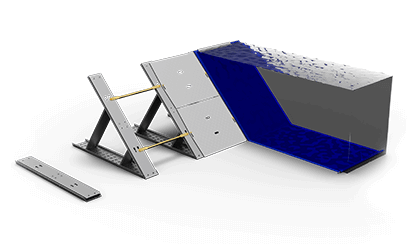On 16 February, as flood threats loomed, the Environment Agency proactively deployed their Heavy Duty C122 Flood Barrier and Heavy Duty C184 Flood Barrier along the Wharfage in Ironbridge Gorge – as they have done on a regular basis, since 2004.
The Environment Agency expressed deep concerns over the excess runoff from the Severn's upper reaches amongst the mountains in Wales. Being familiar with this scenario, the Environment Agency predicted that the flooding in the Severn valley could continue for at least three more days. The situation across several parts of the West Midlands was described as "unprecedented".
Speaking to The Express on 19 February, Environment Agency manager Marc Lidderth could inform that water levels had decreased by around 1cm. However, he emphasised the continued severity, stating: "The severe flood warning we've issued at Ironbridge is still active, indicating a significant risk to life. We urge the public to remain vigilant and follow guidance from the emergency services."

Geodesign Barrier's Heavy Duty C122 and C184 systems seamlessly connect, showcasing their compatibility – a testament to advanced flood defence technology. In the background, the metal storage crates house this robust temporary barrier system, ensuring efficient logistics and deployment during flood emergencies.
By 26 February, the river levels reached a worrying height of 6.79m at the Buildwas gauge in Ironbridge. With Storm Jorge on the horizon, authorities decided to reinforce the existing barriers in anticipation of potential challenges.
On 28-29 February, representatives from Geodesign Barriers Ltd teamed up with their associate Rob Thallon from Robert Nicholas Ltd for a thorough inspection. Environment Agency representatives also participated. By 10am on 28 February, there was some relief as river levels dropped to 5.11m, a significant decline from the recent peak.
The inspection by Geodesign Barriers Ltd highlighted a few areas of concern. The Heavy Duty Flood Barriers rely heavily on friction with the ground. In certain sections, the new road camber had caused reduced friction. Additionally, issues were noted with the plastic membrane's deployment near tree regions, which could lead to vulnerabilities during strong river currents. The team recommended certain adjustments to optimise the barrier's efficiency.
Following the inspection, Environment Agency staff enhanced the barrier setup. Simultaneously, Geodesign Barrier representatives offered on-site training to address the specific challenges identified.

From the vantage point of the iconic Iron Bridge – the first ever iron bridge in the world – the Geodesign Barrier's effective flood defence stretches along the Wharfage in Ironbridge Gorge, safeguarding historical buildings, businesses and residents against rising waters.
By 1 March, the Environment Agency released an advisory noting the rising water levels due to the approaching Storm Jorge. Projections estimated peaks between 5.4 to 5.7 meters on 2 March. However, local authorities remained hopeful, with Telford and Wrekin council expressing optimism that water levels would be at least a meter lower than the previous week. In the backdrop of these developments, local businesses started their journey towards normalisation, with many reopening their doors.
Between 6-7 March, after weathering the impacts of three storms – Ciara, Dennis, and Jorge – the barriers were finally removed. While Storm Jorge was less intense compared to its predecessors, its heavy rainfalls and gusty winds further complicated the scenarios in already flood-affected regions with saturated ground conditions.







